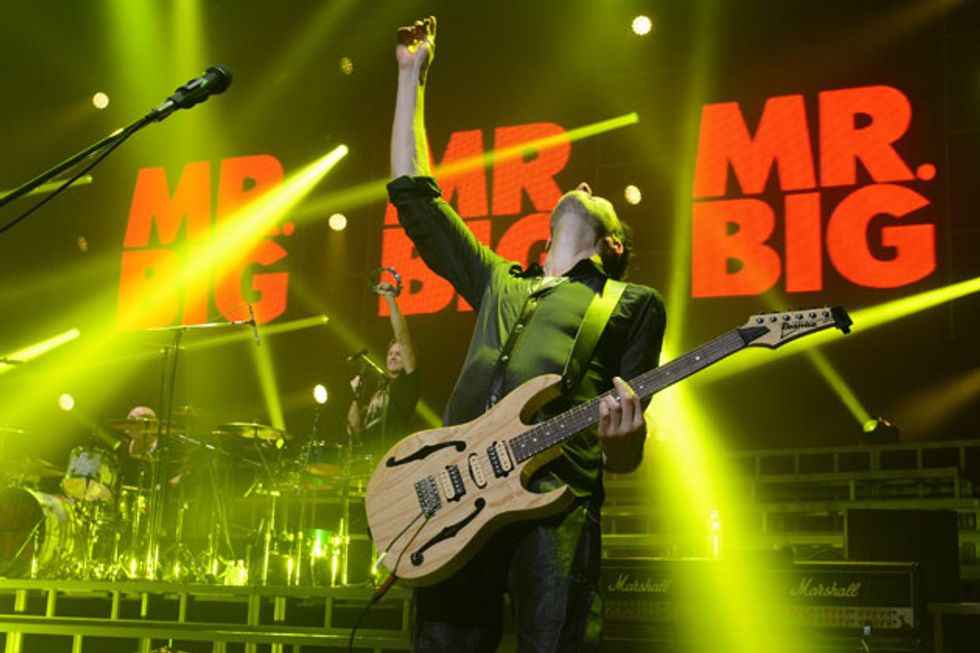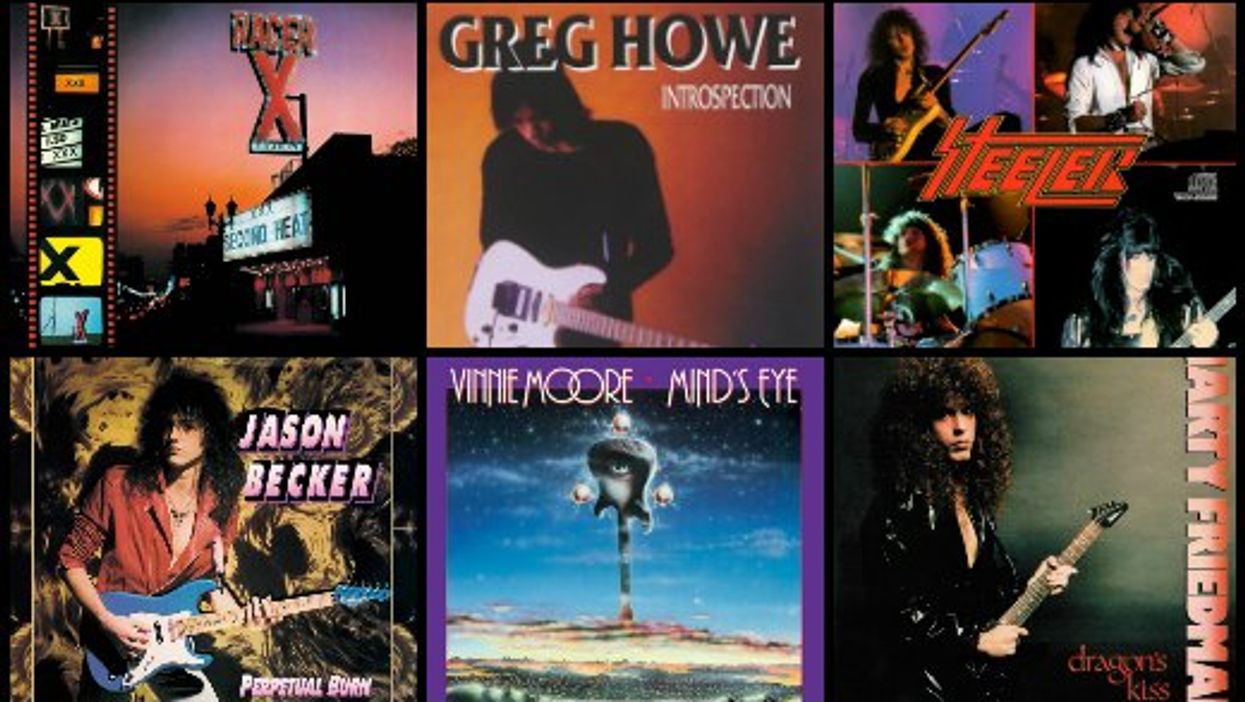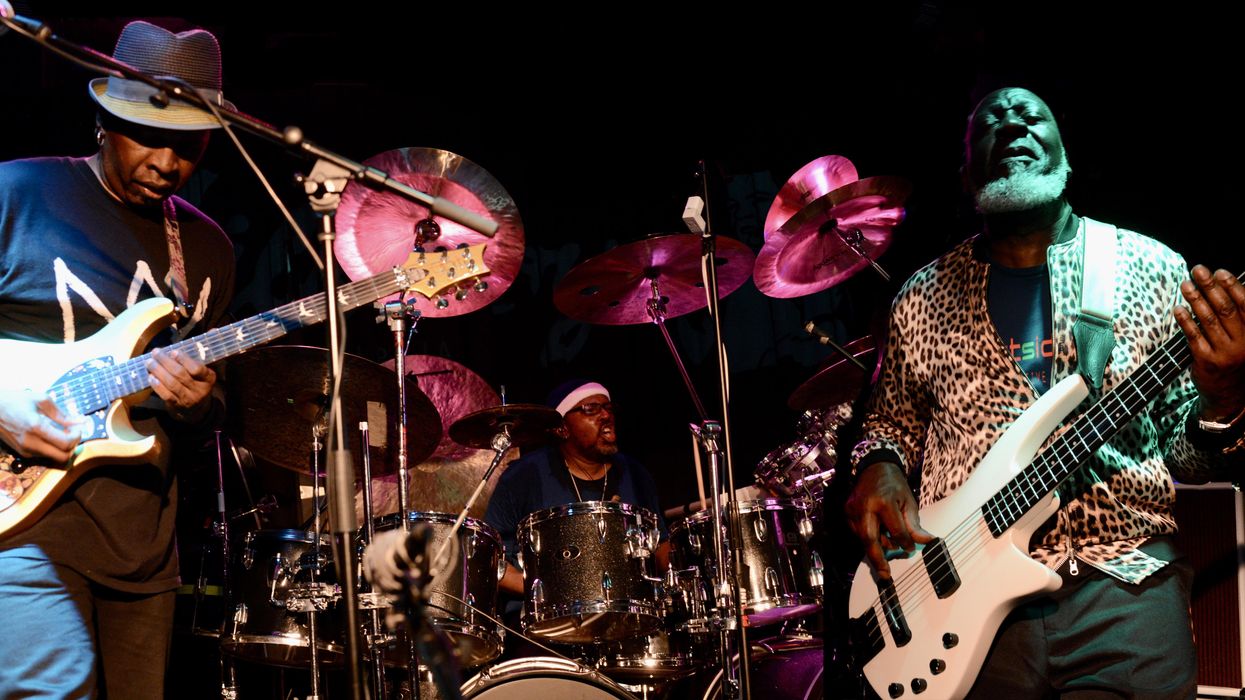Paul Gilbert is a musical chameleon. To some, he’ll always be the ferocious shredder whose mid-’80s nod to Paganini’s “Moto Perpetuo” on the Racer X composition “Y.R.O.” (an acronym for “Yngwie Rip Off”) scarified the shit out of every aspiring virtuoso on the planet. To others, he’s the guy who played on that Mr. Big ballad. To still others, he’s a brilliant and charismatic singer/songwriter whose tunes are informed by the harmonic riches of ’70s pop fused with the full-tilt boogie of the Van Halen songs he cut his teeth on as a preteen.
Regardless of how you categorize Gilbert, there’s no denying the sense of humor that carries across just about everything he does—from using a cordless Makita drill to boost picking speed to ridiculous levels, to the consistently silly song titles on his solo projects. For instance, on his 14th LP, I Can Destroy, the mid-tempo, tongue-in-cheek groover “Everybody Use Your Goddamn Turn Signal” gives voice to the universal driver’s sentiment, and “I Am Not the One (Who Wants to Be with You)” slyly references the aforementioned Mr. Big megahit, “To Be with You.”
But despite his penchant for punch lines, Gilbert approached Destroy with a single-minded seriousness that began with his choice of producer. He settled on Kevin Shirley (Rush, Dream Theater, Joe Bonamassa), whom he’d previously worked with on Mr. Big’s 2010 album, What If….
“With Kevin, it’s three or four takes and that’s it,” says Gilbert. “He’s gonna be going, ‘Okay, what’s the next tune?’ So I knew I really had to deliver a band that sounded complete when we played live—and, as a three-piece, that can be really challenging.” To flesh out the group’s sound, Gilbert recruited guitarists Tony Spinner and Freddie Nelson, both of whom he’d worked with before. “They’re great guitar players and great singers,” Gilbert explains. “We can do the three-part harmonies live, and we can do the vocal harmonies in one take.”
As his reasoning for choosing Spinner and Nelson might indicate, I Can Destroy does focus a bit more on Gilbert’s vocal side—but fear not, guitar nerds, there are still plenty of breathtaking fretboard pyrotechnics. The title track exemplifies Gilbert’s patented brand of twin-guitar harmonies and hyper-speed heroics. And on the jazzy “One Woman Too Many,” the Makita makes a glorious return.
We recently chatted with Gilbert via Skype, where he blazed away on a vintage Ibanez semi-hollowbody as he gave us the lowdown on how horn and reed playersinformed I Can Destroy, how past mistakes affected his career, and how to bridge the eternal shred-versus-blues divide. All the while, his cat, Juliette, scampered around in the background.
This is your 14th solo studio album, among countless other recordings. How do you keep inspired after so many years?
Sometimes I’ll find new music I haven’t heard before. For example, when I did the Fuzz Universe record in 2010, I discovered this classical lute composer and I went through and stole a bunch of chords and made them into my own songs. For this record, a lot of it came from lyrics I’d written in the confines of a van—I was traveling through Italy on a clinic tour and had nothing to do but write. That was a nice thing to build on.
Is it true that you also took inspiration from blues and jazz artists during the album’s formative stages?
Over the last few years I got tired of following my fingers around. I’d been playing for so long … but I found that if I slowed down, my musical intention wasn’t at the level that I wanted it to be—I wasn’t able to play what I heard in my head as well as I wanted to. Blues seemed like a great style of music to work that up with. Plus, I just like that stuff. So I started to research a lot of the artists that I wasn’t that familiar with, not only on guitar, but I listened to a lot of horn players from the ’40s, ’50s, and early ’60s who were jazz players but played blues as well.
Who are some of the players you checked out?
Johnny Hodges, who was Duke Ellington’s sax player. I just love the way he slides into notes. He tends to play pretty slowly most of the time, which is nice, because it’s relatively easy to figure out. But once you do figure it out, you realize that the way he bends might not be possible on guitar—but at least you can try, and it can get you to do things you might not do otherwise.
Also, a clarinet player named Jimmy Hamilton. I just listened until something would catch my ear, and it tended to be slow stuff. Sax and clarinet stuff tends to be really fast swing, but I like it slower. I would search for those slower blues songs where they’re obviously playing with intention and playing what they hear.
Why the jazz bug now, as opposed to when you were at GIT with jazz and fusion guys like Joe Diorio, Don Mock, and Scott Henderson?
Those guys are stunning guitar players, but when it comes to the things that I really like about blues and jazz, so much of it has to do with the vocal quality of it. It’s a style issue. When it comes to fast playing, I tend to like the distorted guys because they tend to have a smooth technique. For example, if you listen to [clarinetist] Artie Shaw’s arpeggios, they sound like Yngwie’s sweep picking. There’s a real effortlessness to it. And there are different kinds of effort. Like, I loved it when Gary Moore played something angry. But when it’s not angry and there’s effort, that’s just not a sound I like that much. A lot of the clean jazz guys, to me, even though they’re stunning—I listen to a Joe Pass record and I’m blown away—sonically, the texture of it isn’t as appealing as listening to Allan Holdsworth or Artie Shaw. When it comes to the slow stuff, I like the guys that bend. From a guitar-playing standpoint, B.B. King or Coco Montoya—he’s one of those upside down guys, so his bends are just ridiculous. Or Hendrix, of course, who was the first guy to use distortion so he could sustain and bend. Before that you had everybody doing that plinky, Ventures kind of stuff. That really transformed the guitar into something more like a voice or a horn.
A lot of the songs on I Can Destroy have colorful harmonies and interesting progressions not often used in pop music. Was that a conscious decision?
I grew up with ’70s pop on the radio and, of course, the Beatles records. So as soon as I hear a secondary dominant chord thrown in, I go, “Oooh, what’s that?” I sometimes do some chord research before I go into a writing session, just so I’ve got some interesting colors to paint with. For example, one chord—and I still don’t even know what it’s called … a lot of times I just relate to the song more than I do the name of the chord—there’s a Beach Boys song called “When I Grow Up to Be a Man,” and I think it’s in G#. The first chord is this crazy F# chord [plays a G#7#5/F#, which is used as the re-harmonized basis for his new tune “On Broadway”]. I could figure out what it is, but even if I did know the name of it, nobody in my band would know it by that, so what’s the point of using this language when nobody speaks it? It’s the first chord of the song, so the next step is I figure out how it relates to the key, then sort of mess around.
The boogie vibe on much of the album is drastically different from the neoclassical sounds you favored when you first hit the scene. How did this shift occur?
Well, I grew up with my dad’s blues records of artists like B.B. King, Muddy Waters, and John Lee Hooker. So that planted the seeds. But as a teenager, I was more into the flashy guitar players—Led Zeppelin, Van Halen, Gary Moore, UFO, Yngwie, and Allan Holdsworth.
The thing that brought me back to the blues was actually being in Racer X with Bruce Bouillet. Once in a while Bruce would start playing blues at rehearsal, and I’d join in and try to jam with him. He’d sound so much better than me and was blowing my socks off. I was like, “Man, I gotta get my blues together.” First off, it was the note choices—he knew the right notes to play. I was playing the natural-minor scales, which would fit great in an Iron Maiden song but were just the wrong notes for the blues. The first step back in that direction was a Pat Travers record called Live! Go for What You Know, an album that had both Travers and a guitar player named Pat Thrall. It’s certainly not a traditional blues record by any stretch of the imagination, but it’s got “Boom, Boom (Out Go the Lights),” which is a quick shuffle. They’re second-generation blues players, and I’m sure they listened to a lot of the original blues guys. So that sort of got me to start re-fingering things.
More recently, it was just listening to B.B. King and watching him on YouTube. Watching “Sweet Sixteen” and that 1974 concert in Africa, and watching how he does that first-finger vibrato—which is something that I procrastinated forever. Also, it was just getting a sense of how blues players are able to play what they hear. There’s enough space and the tempos are slow enough where that’s possible. You know, when you’ve got a metal song that’s cooking along at 100 miles per hour, you might have to rely a little bit more on fingering patterns. Blues is also nice because it has changes. A lot of times the metal stuff doesn’t.
In 1988, the chart-topping Mr. Big was Gilbert’s first professional foray into pop songcraft. Gilbert, here hoisting his signature Ibanez Natural Stain model, still performs and records with the group. Photo by Tami Fukatami
What would you say is harder, shred or blues?
That’s like asking what’s harder, German or French? If you grew up with it, that’s just the language you speak. Like, the metal that came out in 1979 will always be the easiest thing for me, because that’s sort of how I trained. But there was still a connection to blues, at least in the vibrato. To me, the ’70s metal guitar players still had great vibrato—it hadn’t gotten to the point where people didn’t care yet. When I hear a lot of modern metal bands, what they care about is different from the early metal bands. They care about having a chunky tone and unbelievably powerful production, and there might not be any vibrato there, whereas, say, the Scorpions, man—Uli Roth’s vibrato is earth-shaking. As is Ritchie Blackmore’s and Eddie Van Halen’s. Yngwie’s vibrato can make you cry. And Gary Moore was metal before he was blues, as far as his career went—and his vibrato was stunning.
“Adventure and Trouble” features a great example of a bluesy solo.
I would put that one more in the gospel category. The way I got it—and I don’t think I realized I got it from here until afterwards—is, I had the melody and I tried to harmonize the chords on top. But I realized later that if you sing “Mercedes Benz” by Janis Joplin, it fits it exactly. [Sings “Mercedes Benz” to demonstrate.] Those are the exact chords. Of course, on the Janis Joplin song there are no chords at all—it’s a cappella. I actually looked it up on YouTube to see if anyone has ever put a backing to that before, and people had but they didn’t go quite as deep as I did.
Paul Gilbert’s Gear
Guitars
• Ibanez FRM250MF
• Ibanez Custom Fireman with DiMarzio P-90s
• Ibanez PGM700
• Gibson ES-330 with P-90s
• Arnold M.J. Hennig custom acoustic
Amps
• Marshall 2061X
• Marshall 1960TV 4x12 cab
• Germino Lead 55
Effects
• TC Electronic MojoMojo Overdrive
• MXR Phase 90
• MXR Distortion+
• Way Huge Red Llama Overdrive
• Majik Box Fuzz Universe
• Ibanez AF2 Paul Gilbert Signature Airplane Flanger
• Electro-Harmonix Deluxe Electric Mistress
Strings and Picks
• Ernie Ball Super Slinky RPS (.009–.042) strings
• Dunlop Tortex Wedge .50 mm picks
• DiMarzio cables and straps
• Bullet cables
• Direct Sound EX-29 headphones
• Dunlop glass slide
• THD Hot Plate
• Voodoo Lab Pedal Power 2 Plus
• Makita cordless drill
One misconception people have is that you always pick everything in your fast lines.
I remember being a teenager and my guitar-player friends and I would be talking. They’d bring up people like Al Di Meola and Steve Morse and say, “Oh, those guys pick everything.” They would express it almost like they were morally superior for doing that—like it was a given that was better. But to me, that’s completely arbitrary judgment. The pick can give a note a variety of textures—it’s not just one pick sound. You can pick light or hard, use an upstroke or a downstroke, you can use pinch harmonics. A hammer-on or a pull-off has a distinct sound itself. And to limit yourself to only one, first of all, really limits the sounds and colors you can paint with. Second of all, that makes about 80 percent of phrases just impossible to play in a way that flows, is comfortable, and is appealing to the ear because you don’t hear that struggle. A lot of that is enabled because of distortion or compression—because they kind of even out the dynamics. A hammer-on or pull-off, by its nature, is going to be quieter.
It’s funny, sometimes I’ll record a DI track when I’m recording an album. I’ll have a miked-up amp and the DI track, which is just straight out of the guitar with nothing on it. And if you listen to the most ferocious, terrifying shred thing that I do, when you put the DI track on, you can barely hear it because only some of the notes are picked and those will stand out. The hammer-on and pull-off stuff, just dynamically, without distortion, just disappears. It’s sooo quiet. But you put it through the fire-breathing amplifier and it’s fine. It rips people’s faces off. I think that’s one of the reasons why the jazz cats that play with a clean sound almost have to pick everything. You can’t get away with so much legato because it’s so much quieter. Coming from the Eddie Van Halen school of technique, his playing was full of that combination of some picking, some hammer-ons, and pull-offs. It’s not really something that you plan out. Your hands start to develop these habits and you’ve got your licks. But if I suddenly had to pick every note, it would be a very dark day in my life. So much of my playing would just be gone, and the playing that remained would be so stiff and undynamic.
My wife, Emi Gilbert, is a keyboard player, and we were at a piano store where they had a harpsichord. She played a little bit and I said, “Oh, that sounds beautiful, why don’t we buy one?” And she said, “No, I hate playing the harpsichord.” I asked why and she said, “Because there’s no dynamics.” A harpsichord is set up to be like picking everything. You can’t play quiet, you can’t play louder. It’s just one dynamic and it’s mechanically geared that way. It’s kind of cool but you get tired of it quickly as a player because it’s like, “Argh, I just can’t do anything else.” Sometimes with guys that pick everything, I think, “Why don’t you just play harpsichord? It’ll be easier.”
What guitars did you use on I Can Destroy?
I used two Ibanez Firemans. One was a FRM250MF—the orange, flamed-maple model—straight out of the box. The other was a custom-shop white one that’s actually got DiMarzio P-90s. They’re real P-90s that hum because they’re single-coils, and I had to be careful with that one because I couldn’t use it for songs where I had to stop a lot. For example, the opening track, “Everybody Use Your Goddamn Turn Signal,” has big pauses.
For slide, I used this violin-shaped one [pulls out quirky-looking axe], which is an old Ibanez PGM700, I believe. I think I just picked it because it looked cool, but it’s actually difficult to play slide with because you can’t really get past the upper cutaway. But that was a good teacher, because it meant that I had to get my lower-range stuff together—I couldn’t get all screechy and play up high.
I also have a vintage Gibson ES-330 with P-90s that sounds ferocious. I can’t remember which tune I used it on. I might have used it on “One Woman Too Many,” which has kind of a fast picking thing with Em9 to Am11.
You are probably the most successful of the ’80s Shrapnel-label shred guys. What secrets can you offer to aspiring guitarists for career longevity?
I worked pretty hard at it. I’ve done a lot of things that have probably been pretty bad for my career. Right when I quit Mr. Big (he rejoined in 2008), what I should have done was become a shred-guitar instrumentalist. That’s when I should have released [2006’s instrumental] Get Out of My Yard. I would have been a lot more successful if I had done that then. But I didn’t. Instead, I spent the next 10 years trying to be a pop singer. [Laughs.]
But you seem quite successful. It looks like you’ve been on the cover of various Japanese magazines repeatedly for the past 30 years.
It’s a weird thing because, in that period of time, I actually did really well in Japan while I sort of disappeared in the States. And then when I started releasing instrumental albums, all of a sudden, I got on the G3 tour and started doing better in America and Europe. But then in Japan, my career started going down because they wanted to hear me sing. I’ve got this really strange thing now where I’m sort of two different artists. At this point with Japan, I don’t really know what people think. I can never tell except at the shows, and people seem enthusiastic there. In general, I’ve worked really hard doing what I love, and I often look back and think, “That was just a foolish career decision.” I should have done what Yngwie does and just play the same thing and develop a thing where people know what they’re going to get. That’s just Corn Flakes. You pour them out of the box and you know what you’re going to get. But with me, you don’t know what you’re going to get.
You could argue that you’ve had a bigger career than Yngwie over the decades.
I don’t think so. If you look at the venues, Yngwie was headlining Budokan by himself.
Maybe the grass is always greener. And anybody that came up before I did, to me, is always legendary. Yngwie’s records came out a couple of years before I did, and I always put him on a pedestal, where I think he absolutely should be.
YouTube It
Paul Gilbert pays homage to late great Gary Moore and his slow, beautiful blues on his signature Ibanez FRM250.









![Rig Rundown: Russian Circles’ Mike Sullivan [2025]](https://www.premierguitar.com/media-library/youtube.jpg?id=62303631&width=1245&height=700&quality=70&coordinates=0%2C0%2C0%2C0)






















![Rig Rundown: AFI [2025]](https://www.premierguitar.com/media-library/youtube.jpg?id=62064741&width=1245&height=700&quality=70&coordinates=0%2C0%2C0%2C0)




















 Zach loves his Sovtek Mig 60 head, which he plays through a cab he built himself at a pipe-organ shop in Denver. Every glue joint is lined with thin leather for maximum air tightness, and it’s stocked with Celestion G12M Greenback speakers.
Zach loves his Sovtek Mig 60 head, which he plays through a cab he built himself at a pipe-organ shop in Denver. Every glue joint is lined with thin leather for maximum air tightness, and it’s stocked with Celestion G12M Greenback speakers.











